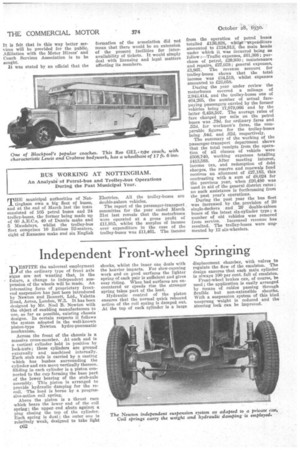Independent Front-wheel Springing
Page 120

If you've noticed an error in this article please click here to report it so we can fix it.
DESPITE the universal employment of the ordinary type of front axle signs are not wanting that, in the future, a change to independent suspension of the wheels will be made. An interesting form of proprietary frontend suspension has just been introduced by Newton and Bennett, Ltd., Valetta Road, Acton, London, W.3. It has been designed by Mr. Noel B. Newton with the object of enabling manufacturers to Ilse, so far as possible, existing chassis designs. In certain respects it follows the system adopted in the well-known piston-type Newton hydro-pneumatic mechanism.
Across the front of the chassis is a massive cross-member. At each end is a vertical cylinder held in position by lock-nuts; these cylinders are ground externally and machined internally. Each stub axle is carried by a casting which has bushes surrounding the cylinder and can move vertically thereon. Sliding in each cylinder is a piston connected to the cup forming the base part of the lower bearing of the stub-axle assembly. This piston is arranged to provide hydraulic damping for the recoil. The load is borne by a progressive-action coil spring.
Above the piston is a thrust race which bears the lower end of the coil spring; the upper. end abuts against a plug closing the top of the cylinder. Each spring is dual ; the outer one is relatively weak, designed to take light shocks, whilst the inner one deals with the heavier impacts. For slow-running work and on good surfaces the lighter spring of each pair is sufficient and gives easy riding. When bad surfaces are encountered or speeds rise the stronger spring takes part of the load.
Hydraulic control of the piston ensures that the normal quick rebound action of the coil spring is damped out. At the top of each cylinder is a large displacement chamber, with valves to regulate the flow of the emulsion. The design ensures that each main cylinder is always 100 per cent. full of emulsion. Front-wheel brakes can, of course, be used ; the application is easily arranged by means of cables passing through flexible but non-extensible sheaths. With a suspension system of this kind unsprung weight is reduced and the steering lock can be improved.




















































































































































































